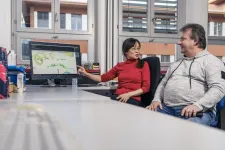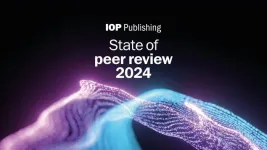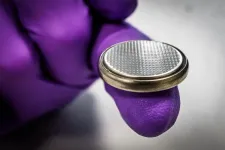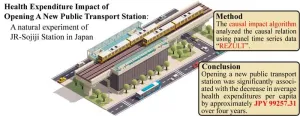(Press-News.org)
Using human cells in laboratory rats, Michigan Medicine researchers have developed a functional model of thoracic aortic aneurysm, creating opportunities for more effective understanding of disease development and treatments for the potentially fatal condition, a study suggests.
There are currently no medical treatments for thoracic aortic aneurysm, which is a weakening and bulging at the body’s largest blood vessel in the chest.
The aneurysm often does not cause any symptoms and must be repaired through open-heart surgery.
It carries high risk of aortic dissection or rupture, which can be lethal.
“Over several decades, drug candidates to treat thoracic aortic aneurysm that succeeded in mouse aneurysm models did not successfully translate over to humans in clinical trials,” said Bo Yang, M.D., Ph.D., a cardiac surgeon and a basic scientist at the University of Michigan Health Frankel Cardiovascular Center who led the research team, which was supported by National Institutes of Health R01 grants.
“We now have the first efficient, 3D model of this disease using human cells. This opens a new avenue for drug development and more effective screening to one day stop the aneurysm before a deadly aortic dissection or rupture.”
To create the model, Yang's research team utilized bioengineered vascular grafts, or BVGs.
They took blood from patients who carried the pathogenic variant that leads to aortic aneurysm, extracted cells and reprogrammed them into induced pluripotent stem cells.
These stems cells were differentiated into smooth muscle cells used for generating the BVGs, since the smooth muscle cells provide structural support for blood vessels and are essential to their function.
Then, they seeded those smooth muscle cells onto biodegradable scaffold, which is a tube-like structure.
The cells grew over eight weeks and took place of the degrading material during that time, eventually forming stable, self-supporting grafts.
“Genetic mutations play a significant role in someone’s susceptibility to developing thoracic aortic aneurysm,” said first author Ying Yang, Ph.D., postdoctoral research fellow in cardiac surgery at U-M Medical School.
“We utilized gene editing to manipulate the gene in human cells, specifically Loeys-Dietz Syndrome, a genetic disorder characterized by aneurysms at the aortic root.”
To test the viability of the aneurysm model, the researchers used CRISPR/Cas9 gene editing to introduce the pathogenic variant in normal human cells to cause the aneurysm; and to correct the variant in the patient’s cells and develop a healthy vascular graft. The control and experimental BVGs were implanted into the carotid arteries of rats.
Over time, the bioengineered grafts carrying the aneurysm variant showed impaired mechanical properties and dilated compared to the healthy grafts.
While the healthy vessel did not dilate, the genetically modified graft grew up to around 40% — resembling human formation of thoracic aortic aneurysm.
The results are published in Science Translational Medicine.
“While we utilized these bioengineered grafts to study the pathogenesis of Loeys Dietz Syndrome, we now have a platform with the potential to be applied to other pathogenic variants associated with thoracic aortic aneurysm and dissection,” said Dogukan Mizrak, Ph.D., co-senior author and research assistant professor of cardiac surgery at U-M Medical School.
“This is a major first step. We have a model that is human cell-based, which puts us in a position to more effectively assess drugs aimed to treat the condition.”
Thoracic aortic aneurysm occurs in approximately six to 10 per 100,000 people.
In 2019, aortic aneurysms and dissections caused over 9,000 deaths in the United States.
“We are currently exploring potential drugs that could be tested using our new, more efficient model,” said Eugene Chen, M.D., Ph.D., co-senior author of the study and Frederick G. L. Huetwell Professor of Cardiovascular Medicine at University of Michigan Medical School.
“This is an incredibly exciting time for research in the area of aortic aneurysm.”
Special thanks to all patients who donated their blood for this research.
Additional authors include Hao Feng, M.D., Ying Tang, Zhenguo Wang, Ph.D., Ping Qiu, Ph.D., Xihua Huang, D.N.P., Lin Chang, Ph.D., Jifeng Zhang, Ph.D., all of University of Michigan.
This study was supported by the National Institutes of Health and the American Heart Association Postdoctoral Fellowship.
Paper cited: “Bioengineered vascular grafts with a pathogenic TGFBR1 variant model aneurysm formation in vivo and reveal underlying collagen defects,” Science Translational Medicine. DOI: 10.1126/scitranslmed.adg6298
END
More than 20,000 volunteers have been recruited to a resource aimed at speeding up the development of much-needed dementia drugs. The cohort will enable scientists in universities and industry to involve healthy individuals who may be at increased risk of dementia in clinical trials to test whether new drugs can slow the decline in various brain functions including memory and delay the onset of dementia.
Using the resource, scientists have already been able to show for the first time that two important bodily mechanisms – inflammation and metabolism – play a role in the decline in brain function as we age.
By ...
Artificial intelligence (AI) computer programs that process MRI results show differences in how the brains of men and women are organized at a cellular level, a new study shows. These variations were spotted in white matter, tissue primarily located in the human brain’s innermost layer, which fosters communication between regions.
Men and women are known to experience multiple sclerosis, autism spectrum disorder, migraines, and other brain issues at different rates and with varying symptoms. A detailed understanding of how ...
Researchers at the Paul Scherrer Institute PSI have for the first time precisely characterised the enzyme styrene oxide isomerase, which can be used to produce valuable chemicals and drug precursors in an environmentally friendly manner. The study appears today in the journal Nature Chemistry.
Enzymes are powerful biomolecules that can be used to produce many substances at ambient conditions. They enable “green” chemistry, which reduces environmental pollution resulting from processes used in synthetic chemistry. One such tool from nature has now been characterised in detail by ...
The huge, long-lasting wildfires that have become increasingly common in recent years can cause changes in soil chemistry that affect water contamination, air quality, and plant growth. But these changes are poorly monitored and rarely factor into post-fire recovery efforts or risk assessments, according to a review study published May 14 in Nature Reviews Earth & Environment.
The study, led by Stanford University and Colorado State University scientists, found that better techniques are needed to monitor changes in soil and surrounding ecosystems. This enhanced ...
Scientists have discovered 17 additional genes that drive the abnormal overgrowth of mutated blood cells as we age. The findings, published today (14 May) in Nature Genetics, provide a more complete view of the genetic factors behind clonal haematopoiesis – a process associated with ageing and linked to increased risks of blood cancers1.
Researchers from the Wellcome Sanger Institute, Calico Life Sciences, California, and the University of Cambridge analysed sequencing data from over 200,000 individuals in the UK Biobank cohort. They searched for genes showing signals of "positive selection" – where mutations ...
An international team led by researchers from the EXOTIC Laboratory of the University of Liège, in collaboration with MIT and the Astrophysics Institute in Andalusia, has just discovered WASP-193b, an extraordinarily low-density giant planet orbiting a distant Sun-like star.
This new planet, located 1,200 light-years from Earth, is 50% larger than Jupiter but seven times less massive, giving it an extremely low density comparable to that of cotton candy. "WASP-193b is the second least dense planet discovered to date, after Kepler-51d, which is much smaller," explains ...
A new global study from IOP Publishing (IOPP) has found that certain peer review communities continue to feel overburdened by reviewer requests, while others remain underrepresented.
The survey, which generated over 3,000 responses from peer reviewers from across the globe, revealed regional and career-stage disparities:
30% of reviewers from high-income countries indicated that they receive too many peer review requests, compared with just 10% from low and middle-income countries*
Just 6% of respondents from China and 7% from India indicated that they ...
A battery made from zinc and lignin that can be used over 8000 times. This has been developed by researchers at Linköping University, Sweden, with a vision to provide a cheap and sustainable battery solution for countries where access to electricity is limited. The study has been published in the journal Energy & Environmental Materials.
“Solar panels have become relatively inexpensive, and many people in low-income countries have adopted them. However, near the equator, the sun sets at around 6 PM, leaving households and businesses without electricity. The hope is that ...
The declining population in Osaka is related to an aging society that is driving up health expenditures. Dr. Haruka Kato, a junior associate professor at Osaka Metropolitan University, teamed up with the Future Co-creation Laboratory at Japan System Techniques Co., Ltd. to conduct natural experiments on how a new train station might impact healthcare expenditures.
JR-Sojiji Station opened in March 2018 in a suburban city on the West Japan Railway line connecting Osaka and Kyoto. The researchers used a causal impact algorithm to analyze the medical expenditure data gathered from the time series medical ...
Compared to Black and Asian people, white and Hispanic people with Alzheimer’s disease and related dementias were most likely to be diagnosed with symptoms like depression and agitation, according to a new study from the USC Schaeffer Center for Health Policy & Economics.
White and Hispanic people with these diagnoses were also most likely to be prescribed central nervous system (CNS) active drugs, including antidepressants, antipsychotics and anticonvulsants. Yet, these drugs have been associated with higher risk of falls, cardiovascular events, hospitalization and death, according to the study published today in the Journal of Alzheimer’s ...



